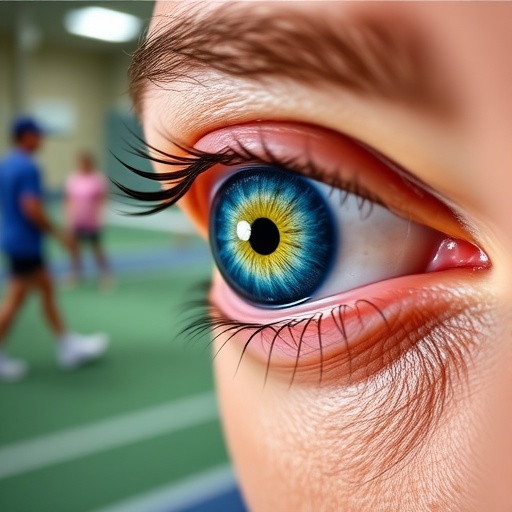As pickleball surges in global popularity, a growing body of evidence now signals an alarming increase in eye injuries related to the sport. A recent study, published in the prestigious journal JAMA Ophthalmology, sheds light on how the rapid expansion of this recreational activity is accompanied by a parallel rise in ocular trauma. The analysis reveals that despite the documented risk to players’ vision, no standardized guidelines currently exist mandating eye protection for either amateur enthusiasts or professional competitors. This gap in safety protocols underscores an urgent public health issue requiring immediate attention from sports regulatory bodies and medical professionals.
Pickleball, a hybrid sport combining elements of tennis, badminton, and table tennis, has captivated millions with its accessibility and fast-paced gameplay. However, its unique characteristics—such as a small court area and the use of lightweight paddles striking a hard plastic ball—create an environment ripe for eye injuries. The trajectory and speed of the ball, combined with players’ rapid movements, substantially increase the likelihood of accidental impacts to the face and eye region. The study meticulously tracked ocular injury patterns over the past four years, demonstrating a disturbing upward trend parallel to the sport’s meteoric rise.
Clinically, these eye injuries range from minor abrasions and contusions to severe traumas, including hyphema (bleeding in the anterior chamber), orbital fractures, and even globe rupture. Such injuries can culminate in lasting vision impairment or irreversible blindness if not promptly treated. The researchers employed data from emergency department visits, sports medicine records, and ophthalmologic assessments to characterize the severity and frequency of pickleball-related ocular trauma. Analysis revealed that a significant portion of injuries occur during casual, unregulated play, where protective gear is rarely utilized.
One of the most striking findings from the study is the absence of mandatory protective eyewear across all levels of lineup, including competitive professional leagues. Unlike sports such as racquetball and squash, where ANSI-standard protective goggles are enforced, pickleball remains largely unregulated in this aspect. This regulatory vacuum leaves players vulnerable to preventable injuries. The authors advocate for the development of comprehensive, evidence-based safety standards, which would include the mandatory use of certified eye protection during play as a critical preventative measure.
The biomechanics of injury in pickleball further exacerbate the risk to ocular tissues. The sport’s confined court dimensions lead to near-constant player proximity, increasing the risk of unintentional paddle or ball contact with the eye. The ball’s relatively small diameter and rapid velocity enable it to penetrate the protective reflexes of players, striking the eye with substantial force. Ophthalmologists note that such injuries often involve blunt force trauma capable of causing retinal detachment, traumatic iritis, and optic nerve damage—conditions that frequently necessitate surgical intervention.
Furthermore, demographic patterns from the study indicate that older adults—who constitute a substantial portion of the pickleball community—are disproportionately affected by eye injuries. Age-related changes in ocular anatomy and slower reflexive responses may contribute to increased susceptibility. This emphasizes the need for targeted education and protective strategies tailored to vulnerable groups within the sport’s diverse participant base. The researchers suggest integrating eye safety awareness programs into recreational centers and senior clubs where pickleball is widely played.
Emergency medicine practitioners are also seeing an uptick in pickleball-associated ocular emergencies. Hospitals and urgent care facilities report increased patient volumes presenting with eye trauma linked directly to the sport. This surge not only stresses healthcare resources but also highlights the societal cost of preventable sports-related injuries. Early intervention and increased vigilance among medical professionals are crucial to improving clinical outcomes and functional recovery for affected individuals.
From a public health perspective, the study underscores a broader conversation about injury prevention in rapidly evolving recreational activities. The proliferation of firsthand and social media accounts documenting pickleball eye injuries has already sparked grassroots calls for reform. Experts recommend that governing bodies collaborate with ophthalmology societies to draft standardized regulations. These should encompass protective eyewear certification, player education mandates, and injury surveillance systems to monitor incidence trends continuously.
Technological advances in eye protection materials and design offer promising avenues to enhance player safety without compromising comfort or performance. Modern polymer lenses with anti-fog and impact-resistant properties can feasibly be integrated into sport-specific eyewear. The study’s authors emphasize that such innovations, paired with effective advocacy and policy implementation, could dramatically reduce the frequency and severity of pickleball-related ocular injuries in coming years.
In summary, the growing popularity of pickleball has paradoxically given rise to a hidden epidemic of eye injuries. The newly published research in JAMA Ophthalmology presents compelling evidence of this trend and calls for immediate, coordinated action to establish protective guidelines. Without such measures, the risk of vision-threatening trauma will continue to escalate, undermining the sport’s appeal and safety. Stakeholders across medical, regulatory, and athletic domains must unite to safeguard the vision health of pickleball players worldwide.
For those invested in sports medicine, ophthalmology, and injury prevention, this study serves as a clarion call to address a burgeoning public health challenge. Incorporating mandatory eye protection into pickleball’s safety culture offers the most effective barrier against ocular trauma. As the sport’s community expands globally, prioritizing player safety must become a foundational principle to ensure that pickleball remains both an enjoyable and secure recreational pursuit.
Subject of Research: Eye injuries related to pickleball and the need for standardized eye protection guidelines.
Article Title: Not provided in the source content.
Keywords: Sports medicine, Sports, Traumatic injury, Eye, Emergency medicine, Patient monitoring, Risk factors, Ophthalmology
Tags: eye injury trends in pickleballimpact of sports on visionJAMA Ophthalmology studyocular trauma in sportspickleball eye injuriespickleball popularity and riskspreventing sports-related eye injuriespublic health concerns in sportsrecreational sports safetyrising emergency room visitssafety protocols in pickleballstandardized eye protection guidelines





